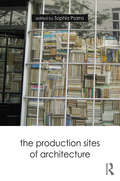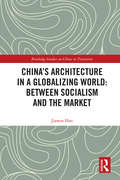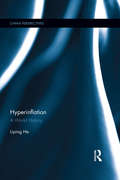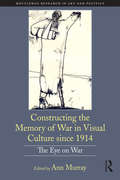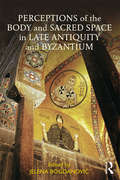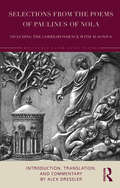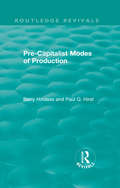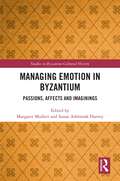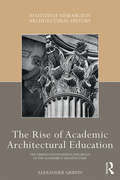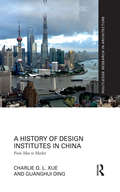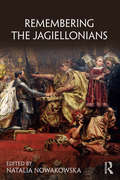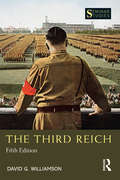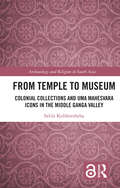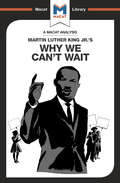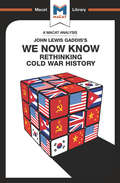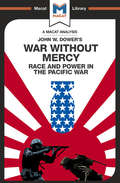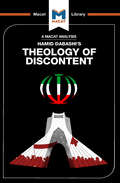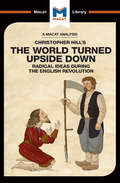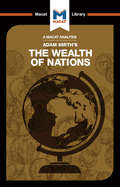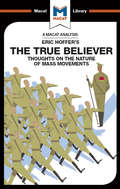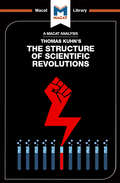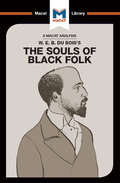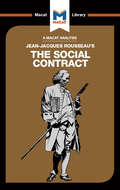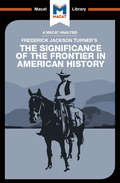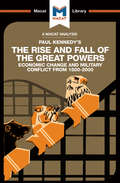- Table View
- List View
The Production Sites of Architecture
by Sophia PsarraThe Production Sites of Architecture examines the intimate link between material sites and meaning. It explores questions such as: how do spatial configurations produce meaning? What are alternative modes of knowledge production? How do these change our understanding of architectural knowledge? Featuring essays from an international range of scholars, the book accepts that everything about the production of architecture has social significance. It focuses on two areas: firstly, relationships of spatial configuration, form, order and classification; secondly, the interaction of architecture and these notions with other areas of knowledge, such as literature, inscriptions, interpretations, and theories of classification, ordering and invention. Moving beyond perspectives which divide architecture into either an aesthetic or practical art, the authors show how buildings are informed by intersections between site and content, space and idea, thought and materiality, architecture and imagination. Presenting illustrated case studies of works by architects and artists including Amale Andraos, Dan Wood, OMA, Koen Deprez and John Soane, The Production Sites of Architecture makes a major contribution to our understanding of architectural theory.
China's Architecture in a Globalizing World: Between Socialism And The Market (Routledge Studies on China in Transition)
by Jiawen HanChina is currently in the midst of an unprecedented building boom and, indeed, interest in Chinese contemporary architecture has been fuelled by this huge expansion. Through a cutting-edge theoretical discussion of Chinese architecture in relation to Chinese modernity, this book examines this phenomenon in detail. In particular, it highlights how changes in the social-political system, the residual influence of Mao and the demands of the market have each shaped and determined style and form in recent years. Using key case studies of Liu Jiakun, Cui Kai, and URBANUS, it analyses the intricate details of historical pressures and practical strategies affecting Chinese architecture. In doing so, it demonstrates that Chinese architects contribute in specific ways to the international architectural discourse, since they are actively engaging with the complex societal transition of contemporary China and managing the dynamics and conflicts arising during the process. China's Architecture in a Globalizing World: Between Socialism and the Market offers a lens into the innovation and uniqueness of architectural design in China. As such, this book will be useful for students and scholars of architecture, Chinese culture and society and urban studies.
Hyperinflation: A World History (China Perspectives)
by He LipingSince 1970s when the world was experiencing an "age of inflation", a great volume of academic research about hyperinflation has been conducted. However, it is also true that parrot-like superficial talks abound, without questioning the economic, political and social foundations existing underneath the economic phenomenon. Based on research results of contemporary economists, media reports and historical works, this book will be the most comprehensive narrative of all major events of hyperinflation worldwide from the turn of the first millennium to the mid-2010s. Firstly, it gives a brief illustration of the basic concepts of hyperinflation, starting with the definitions and price measurement. Then it traces and analyzes all major episodes of hyperinflation that occurred over the past two thousand years or so, from the earliest incidence to the four tidal waves in the 20th century, and to the three latest episodes in the 21st century. Using basic concepts in modern finance such as indexation and dollarization, this book explains why hyperinflation in some countries could explode into astronomical levels, while rhythms of hyperinflation in the 20th century world are in resonance of megatrends in world economy and politics. Finally, this book underscores the importance of policy making, institutional building and international relations in the process of hyperinflation and stabilization. Scholars and students studying money and finance, economic history, international finance and economics will be attracted by this book.
Constructing the Memory of War in Visual Culture since 1914: The Eye on War (Routledge Research in Art and Politics)
by Ann MurrayThis collection provides a transnational, interdisciplinary perspective on artistic responses to war from 1914 to the present, analysing a broad selection of the rich, complex body of work which has emerged in response to conflicts since the Great War. Many of the creators examined here embody the human experience of war: first-hand witnesses who developed a unique visual language in direct response to their role as victim, soldier, refugee, resister, prisoner and embedded or official artist. Contributors address specific issues relating to propaganda, wartime femininity and masculinity, women as war artists, trauma, the role of art in soldiery, memory, art as resistance, identity and the memorialisation of war.
Perceptions of the Body and Sacred Space in Late Antiquity and Byzantium
by Jelena BogdanovicPerceptions of the Body and Sacred Space in Late Antiquity and Byzantium seeks to reveal Christian understanding of the body and sacred space in the medieval Mediterranean. Case studies examine encounters with the holy through the perspective of the human body and sensory dimensions of sacred space, and discuss the dynamics of perception when experiencing what was constructed, represented, and understood as sacred. The comparative analysis investigates viewers’ recognitions of the sacred in specific locations or segments of space with an emphasis on the experiential and conceptual relationships between sacred spaces and human bodies. This volume thus reassesses the empowering aspects of space, time, and human agency in religious contexts. By focusing on investigations of human endeavors towards experiential and visual expressions that shape perceptions of holiness, this study ultimately aims to present a better understanding of the corporeality of sacred art and architecture. The research points to how early Christians and Byzantines teleologically viewed the divine source of the sacred in terms of its ability to bring together – but never fully dissolve – the distinctions between the human and divine realms. The revealed mechanisms of iconic perception and noetic contemplation have the potential to shape knowledge of the meanings of the sacred as well as to improve our understanding of the liminality of the profane and the sacred.
Selections from the Poems of Paulinus of Nola, including the Correspondence with Ausonius: Introduction, Translation, and Commentary (Routledge Later Latin Poetry)
by Alex DresslerThis volume offers a broad introduction to one of the most exciting chapters of Late Antiquity through direct testimony from one of the last representatives of Roman Antiquity, Ausonius of Bordeaux, and his radical Christian protégé, the populist bishop and experimental poet Paulinus of Nola. The first comprehensive volume in English dedicated to these works in over a century, this book also offers representative selections from Paulinus’ vast poetic output, from the publicly performed poems that mark his contribution to the emerging cult of the saints to his experimental Christianization of a wide range of Classical genres. Preceded by a substantial introduction discussing the modern significance of these works and their original contexts, the translation is accompanied by running notes for ease of reference and an interpretive commentary rich with illustrative parallels. Taken together, the correspondence with Ausonius and the selections from Paulinus epitomize the personal, political, and spiritual conflicts of their age, offering a lively and concentrated introduction to the life and thought of these two underappreciated contemporaries of Jerome and Augustine. Accompanied by new and provocative interpretations with detailed but concise historical and biographical guidance, this accessible and stylish translation will appeal to scholars and students of Classics, Late Antiquity, religious studies, social history, and world literature.
Routledge Revivals: An Auto-critique Of Pre-capitalist Modes Of Production (Routledge Revivals)
by Paul Q. Hirst Barry HindessFirst published in 1975, this book investigates the various pre-capitalist modes of production briefly indicated in the works of Marx and Engels, and gives an examination of the conditions of the transition from one mode of production to another. The fundamental concepts used in these investigations, including those of mode of production, of necessary labour and surpass labour, of politics and state, are derived from Capital and from other works of Marxist theory. The primary aim of the analysis is to raise the conceptualisation of pre-capitalist modes of production and of transition to a more rigorous level. This book will appear controversial to both Marxists and non-Marxists alike.
Managing Emotion in Byzantium: Passions, Affects and Imaginings (Studies in Byzantine Cultural History)
by Susan Ashbrook Harvey Margaret MullettByzantinists entered the study of emotion with Henry Maguire’s ground-breaking article on sorrow, published in 1977. Since then, classicists and western medievalists have developed new ways of understanding how emotional communities work and where the ancients’ concepts of emotion differ from our own, and Byzantinists have begun to consider emotions other than sorrow. It is time to look at what is distinctive about Byzantine emotion. This volume is the first to look at the constellation of Byzantine emotions. Originating at an international colloquium at Dumbarton Oaks, these papers address issues such as power, gender, rhetoric, or asceticism in Byzantine society through the lens of a single emotion or cluster of emotions. Contributors focus not only on the construction of emotions with respect to perception and cognition but also explore how emotions were communicated and exchanged across broad (multi)linguistic, political and social boundaries. Priorities are twofold: to arrive at an understanding of what the Byzantines thought of as emotions and to comprehend how theory shaped their appraisal of reality. Managing Emotion in Byzantium will appeal to researchers and students alike interested in Byzantine perceptions of emotion, Byzantine Culture, and medieval perceptions of emotion.
The Rise of Academic Architectural Education: The origins and enduring influence of the Académie d’Architecture (Routledge Research in Architectural History)
by Alexander GriffinAcademic architectural education started with the inauguration of the Académie d'Architecture on 3 December 1671 in France. It was the first institution to be devoted solely to the study of architecture, and its school was the first dedicated to the explicit training of architectural students. The Académie was abolished in 1793, during the revolutionary turmoil that besieged France at the end of the eighteenth century, although the architectural educational tradition that arose from it was resurrected with the formation of the École des Beaux-Arts and prevails in the ideologies and activities of schools of architecture throughout the world today. This book traces the previously neglected history of the Académie’s development and its enduring influence on subsequent architectural schools throughout the following centuries to the present day. Providing a valuable context for current discussions in architectural education, The Rise of Academic Architectural Education is a useful resource for students and researchers interested in the history and theory of art and architecture.
A History of Design Institutes in China: From Mao to Market (Routledge Research in Architecture)
by Charlie Q. Xue Guanghui DingA History of Design Institutes in China examines the intricate relationship between design institutes, the state, and, in later periods, the market economy through a carefully situated discussion of significant theoretical and historical issues including socialist utopia, collective and individual design, structural transformation, and architectural exportation, amongst others. It shows how, over the past six decades, China’s design institutes have served the state’s strategy for socialist construction and urbanisation to create socioeconomic and cultural value. Through first-hand research, authors Xue and Ding reveal how the tensions between pragmatism, creativity, collaboration, and resistance have played a crucial role in defining architectural production. Appealing to academics, researchers, and graduate students, this book provides a much-needed contribution to the discourse on architectural history, building practices, and policymaking in contemporary China.
Remembering the Jagiellonians (Remembering the Medieval and Early Modern Worlds)
by Natalia NowakowskaRemembering the Jagiellonians is the first study of international memories of the Jagiellonians (1386–1596), one of the most powerful but lesser known royal dynasties of Renaissance Europe. It explores how the Jagiellonian dynasty has been remembered since the early modern period and assesses its role in the development of competing modern national identities across Central, Eastern and Northern Europe. Offering a wide-ranging panoramic analysis of Jagiellonian memory over five hundred years, this book includes coverage of numerous present-day European countries, ranging from Bavaria to Kiev, and from Stockholm to the Adriatic. In doing so, it allows for a large, multi-way comparison of how one shared phenomenon has been, and still is, remembered in over a dozen neighbouring countries. Specialists in the history of Europe are brought together to apply the latest questions from memory theory and to combine them with debates from social science, medieval and early modern European history to engage in an international and interdisciplinary exploration into the relationship between memory and dynasty through time. The first book to present the Jagiellonians' supranational history in English, Remembering the Jagiellonians opens key discussions about the regional memory of Europe and considers the ongoing role of the Jagiellonians in modern-day culture and politics. It is essential reading for students of early modern and late medieval Europe, ninteenth-century nationalism and the history of memory.
The Third Reich (Seminar Studies)
by David G. WilliamsonThe Third Reich is a succinct, comprehensive examination of the major debates surrounding this crucial period in modern German history. The character and operation of the Nazi state, and of its global consequences, have been discussed and disputed since 1933. David G. Williamson’s Seminar Studies text, now in its fifth edition, provides students with a lucid introduction to the Third Reich and highlights the relevant research, scholarship and controversies. The new edition has been expanded to give increased coverage to such topics as: ethnic cleansing in Poland and Russia, the role of the Wehrmacht, the Holocaust, attitudes of ordinary Germans to the Third Reich, the German opposition, Nazi foreign policy and the German economy. Accompanied by a wide range of primary sources, a timeline, maps and a glossary, The Third Reich remains the best available introduction to this short-lived but enormously impactful period in world history.
From Temple to Museum: Colonial Collections and Umā Maheśvara Icons in the Middle Ganga Valley (Archaeology and Religion in South Asia)
by Salila KulshreshthaReligious icons have been a contested terrain across the world. Their implications and understanding travel further than the artistic or the aesthetic and inform contemporary preoccupations.This book traces the lives of religious sculptures beyond the moment of their creation. It lays bare their purpose and evolution by contextualising them in their original architectural or ritual setting while also following their displacement. The work examines how these images may have moved during different spates of temple renovation and acquired new identities by being relocated either within sacred precincts or in private collections and museums, art markets or even desecrated and lost. The book highlights contentious issues in Indian archaeology such as renegotiating identities of religious images, reuse and sharing of sacred space by adherents of different faiths, rebuilding of temples and consequent reinvention of these sites. The author also engages with postcolonial debates surrounding history writing and knowledge creation in British India and how colonial archaeology, archival practices, official surveys and institutionalisation of museums has influenced the current understanding of religion, sacred space and religious icons. In doing so it bridges the historiographical divide between the ancient and the modern as well as socio-religious practices and their institutional memory and preservation. Drawn from a wide-ranging and interdisciplinary study of religious sculptures, classical texts, colonial archival records, British travelogues, official correspondences and fieldwork, the book will interest scholars and researchers of history, archaeology, religion, art history, museums studies, South Asian studies and Buddhist studies.
Why We Can't Wait
by Jason XidiasMartin Luther King’s policy of non-violent protest in the struggle for civil rights in the United States during the second half of the twentieth century led to fundamental shifts in American government policy relating to segregation, and a cultural shift in the treatment of African Americans. King’s1964 book Why We Can’t Wait creates strong, well-structured arguments as to why he and his followers chose to wage a nonviolent struggle in the fight to advance freedom and equality for black people following ‘three hundred years of humiliation, abuse, and deprivation.’ The author highlights a number of reasons why African Americans must demand their civil rights, including frustration at the lack of political will to tackle racism and inequality. Freedoms gained by African nations after years of colonial rule, as well as the US trumpeting its own values of freedom and equality in an ideological war with the Soviet Union, also played their part. King dealt with the counter-argument that civil rights for blacks would be detrimental to whites in America by explaining that racism is a disease that deeply penetrates both the white and the black psyche. His reasoning dictated that the brave act of nonviolent mass protest would provoke the kind of thinking that would eventually eliminate racism, and give birth to equality for all of ‘God’s children.’
We Now Know: Rethinking Cold War History
by Jason Xidias Scott GilfillanJohn Lewis Gaddis had written four previous books on the Cold War by the time he published We Now Know – so the main thrust of his new work was not so much to present new arguments as to re-examine old ones in the light of new evidence that began emerging from behind the Iron Curtain after 1990. In this respect, We Now Know can be seen as an important exercise in evaluation; Gaddis not only undertook to reassess his own positions – arguing that this was the only intellectually honest course open to him in such changing circumstances – but also took the opportunity to address criticisms of his early works, not least by post-revisionist historians. The straightforwardness and flexibility that Gaddis exhibited in consequence enhanced his book's authority. He also deployed interpretative skills to help him revise his methodology and reinterpret key historical arguments, integrating new, comparative histories of the Cold War era into his broader argument.
War Without Mercy: Race and Power in the Pacific War
by Jason Xidias Vincent SanchezJohn Dower’s War Without Mercy is an attempt to resolve the problem of why the United States fought World War II so very differently in the Pacific and European theaters. Specifically, the author sets out to explain why there was such vicious hostility between the US and Japan during the conflict. This was not merely a matter of outrage at Pearl Harbor, and understanding the phenomenon required going beyond the usual strategic, diplomatic and operational records that fuel most histories of war. Dower looked instead for alternate possibilities – and found them. His book argues that the viciousness that marked fighting in the Pacific had deep roots in popular culture which created frightening racial stereotypes of the enemy on both sides of the ocean. Dower's focus on ‘low culture’ proved to be a useful way of generating alternative possibilities to mainstream thinking about US-Japanese relations. The thinking underpinning the book was innovative, and was challenged by some peers who failed to recognise how profoundly revealing material such as cartoons and cheap magazines could be. But the result was one of the most significant studies of 20th-century history yet written – one that yields a strong, well-reasoned and persuasive solution to the problem posed.
Theology of Discontent: The Ideological Foundation of the Islamic Revolution in Iran
by Bryan Gibson Magdalena C. DelgadoHamid Dabashi’s 1997 work Theology of Discontent reveals a creative thinker capable not only of understanding how an argument is built, but also of redefining old issues in new ways. The Iranian Revolution of 1978–9 was front-page news in the West, and in some ways remains so today. Though it was an uprising against authoritarian royal rule, with a coalition of modernisers and Islamists, the revolution saw the birth of a new Islamic Republic that seemed to reject pro-Western democracy. Dabashi wanted to analyze the real reasons for this change, while examining how Islamic ideologies contributed to the revolution and the republic that followed. Theology of Discontent examines different Islamic thinkers, analyzing how views with seemingly little in common contributed to the modern Iranian belief system. Beyond its insightful analytical dissection of these eight thinkers, Theology of Discontent also shows Dabashi’s creative thinking skills. Reframing the debates about Iran’s relationship with the West, he traced the ways in which Iranian identity formed in reactive opposition to Western ideas. In many ways, Dabashi suggested, Iran was trapped in a cycle of deliberately asserting its difference from the West, a process that was fundamental to the development of its own unique brand of revolutionary Islamism.
The World Turned Upside Down
by Harman Bhogal Liam HaydonFew works of history have succeeded so completely in forcing their readers to take a fresh look at the evidence as Christopher Hill's The World Turned Upside Down – and that achievement is rooted firmly in Hill's exceptional problem-solving skills. Traditional interpretations of the English Civil War concentrated heavily on a top-down analysis of the doings of king and parliament. Hill looked at ‘history from below,’ focusing instead on the ways in which the people of Britain saw the society they lived in and nurtured hopes for a better future. Failing to understand these factors – and the impact they had on the origins and outcomes of the wars of the 1640s – means failing to understand the historical period. In this sense, Hill's influential work is a great example of the problem-solving skills of asking productive questions and generating alternative possibilities. It forced a generation of historians to re-evaluate the things they thought they knew about a key pivot point in British history – and went on to influence the generations that came after them.
The Wealth of Nations
by John CollinsAdam Smith’s 1776 Inquiry into The Nature and Causes of the Wealth of Nations – more often known simply as The Wealth of Nations – is one of the most important books in modern intellectual history. Considered one of the fundamental works of classical economics, it is also a prime example of the enduring power of good reasoning, and the ability of reasoning to drive critical thinking forward. Adam Smith was attempting to answer two complex questions: where does a nation’s wealth come from, and what can governments do to increase it most efficiently? At the time, perhaps the most widely accepted theory, mercantilism, argued that a nation’s wealth was literally the amount of gold and silver it held in reserve. Smith, meanwhile, weighed the evidence and came to a different conclusion: a nation’s wealth, he argued, lay in its ability to encourage economic activity, largely without government interference. Underlying this radical redefinition was the revolutionary concept that powered Smith’s reasoning and which continues to exert a vast influence on economic thought: the idea that markets are self-regulating. Pitting his arguments against those of his predecessors, Smith carefully and persuasively reasoned out a strong case for free markets that reshaped government economic policies in the 19th-century and continues to shape global prosperity today.
The True Believer: Thoughts on the Nature of Mass Movements
by Jonah S. RubinEric Hoffer’s The True Believer: Thoughts on the Nature of Mass Movements is one of the most widely read works of social psychology written in the 20th-century. It exemplifies the powers of creative thinking and critical analysis at their best, providing an insight into two crucial elements of critical thinking. Hoffer is likely to go down in history as one of America’s great creative thinkers – a writer not bound by standard frameworks of thinking or academic conventions, willing to beat his own path in framing the best possible answers to the questions he investigated. An impoverished, largely unschooled manual laborer who had survived the worst effects of the Great Depression in the United States, Hoffer was a passionate autodidact whose philosophical and psychological education came from omnivorous reading. Working without the help of any mentors, he forged the fearsomely creative and individual approach to problems demonstrated in The True Believer. The book, which earned him his reputation, examines the different phenomena of fanaticism – religious or political – and applies Hoffer’s analytical skills to reveal that, deep down, all ‘true believers’ display the same needs and tendencies, whatever their final choice of belief. Incisive and persuasive, it remains a classic.
The Structure of Scientific Revolutions
by Jo Hedesan Joseph TendlerThomas Kuhn’s The Structure of Scientific Revolutions can be seen, without exaggeration, as a landmark text in intellectual history. In his analysis of shifts in scientific thinking, Kuhn questioned the prevailing view that science was an unbroken progression towards the truth. Progress was actually made, he argued, via "paradigm shifts", meaning that evidence that existing scientific models are flawed slowly accumulates – in the face, at first, of opposition and doubt – until it finally results in a crisis that forces the development of a new model. This development, in turn, produces a period of rapid change – "extraordinary science," Kuhn terms it – before an eventual return to "normal science" begins the process whereby the whole cycle eventually repeats itself. This portrayal of science as the product of successive revolutions was the product of rigorous but imaginative critical thinking. It was at odds with science’s self-image as a set of disciplines that constantly evolve and progress via the process of building on existing knowledge. Kuhn’s highly creative re-imagining of that image has proved enduringly influential – and is the direct product of the author’s ability to produce a novel explanation for existing evidence and to redefine issues so as to see them in new ways.
The Souls of Black Folk
by Jason XidiasW.E.B Du Bois’ The Souls of Black Folk is a seminal work in the field of sociology, a classic of American literature – and a solid example of carefully-structured reasoning. One of the most important texts ever written on racism and black identity in America, the work contains powerful arguments that illustrate the problem of the position of black people in the US at the turn of the 20th-century. Du Bois identified three significant issues (‘the color line’; ‘double consciousness’; and ‘the veil’) that acted as roadblocks to true black emancipation, and showed how each of these in turn contributed to the problem of inequality. Du Bois carefully investigates all three problems, constructing clear explanations of their significance in shaping the consciousness of a community that has been systematically discriminated against, and dealing brilliantly with counter-arguments throughout. The Souls of Black Folk went on to profoundly influence the civil rights movement in the US, inspiring post-colonial thinking worldwide.
The Social Contract
by James HillFew people can claim to have had minds as fertile and creative as the French philosopher Jean-Jacques Rousseau. One of the most influential political theorists of the modern age, he was also a composer and writer of opera, a novelist, and a memoirist whose Confessions ranks as one of the most striking works of autobiography ever written. Like many creative thinkers, Rousseau was someone whose restless mind could not help questioning accepted orthodoxies and looking at matters from novel and innovative angles. His 1762 treatise The Social Contract does exactly that. Examining the nature and sources of legitimate political power, it crafted a closely reasoned and passionately persuasive argument for democracy at a time when the most widely accepted form of government was absolute monarchy, legitimised by religious beliefs about the divine right of kings and queens to rule. In France, the book was banned by worried Catholic censors; in Rousseau’s native Geneva, it was both banned and burned. But history soon pushed Rousseau’s ideas into the mainstream of political theory, with the French and American revolutions paving the way for democratic government to gain ground across the Western world. Though it was precisely what got Rousseau’s book banned at the time, the novel idea that all legitimate government rests on the will of the people is now recognised as the core principle of democratic freedom and represents, for many people, the highest of ideals.
The Significance of the Frontier in American History
by Joanna Dee Das Joseph TendlerFrederick Jackson Turner's 1893 essay on the history of the United States remains one of the most famous and influential works in the American canon. That is a testament to Turner's powers of creative synthesis; in a few short pages, he succeeded in redefining the way in which whole generations of Americans understood the manner in which their country was shaped, and their own character moulded, by the frontier experience. It is largely thanks to Turner's influence that the idea of America as the home of a sturdily independent people – one prepared, ultimately, to obtain justice for themselves if they could not find it elsewhere – was born. The impact of these ideas can still be felt today: in many Americans' suspicion of "big government," in their attachment to guns – even in Star Trek's vision of space as "the final frontier." Turner's thesis may now be criticised as limited (in its exclusion of women) and over-stated (in its focus on the western frontier). That it redefined an issue in a highly impactful way – and that it did so exceptionally eloquently – cannot be doubted.
The Rise and Fall of the Great Powers: Economic Change and Military Conflict From 1500-2000
by Riley QuinnPaul Kennedy owes a great deal to the editor who persuaded him to add a final chapter to this study of the factors that contributed to the rise and fall of European powers since the age of Spain’s Philip II. This tailpiece indulged in what was, for an historian, a most unusual activity: it looked into the future. Pondering whether the United States would ultimately suffer the same decline as every imperium that preceded it, it was this chapter that made The Rise and Fall of the Great Powers a dinner party talking point in Washington government circles. In so doing, it elevated Kennedy to the ranks of public intellectuals whose opinions were canvassed on matters of state policy. From a strictly academic point of view, the virtues of Kennedy's work lie elsewhere, and specifically in his flair for asking the sort of productive questions that characterize a great problem-solver. Kennedy's work is an example of an increasingly rare genre – a work of comparative history that transcends the narrow confines of state– and era–specific studies to identify the common factors that underpin the successes and failures of highly disparate states. Kennedy's prime contribution is the now-famous concept of ‘imperial overstretch,’ the idea that empires fall largely because the military commitments they acquire during the period of their rise ultimately become too much to sustain once they lose the economic competitive edge that had projected them to dominance in the first place. Earlier historians may have glimpsed this central truth, and even applied it in studies of specific polities, but it took a problem-solver of Kennedy's ability to extend the analysis convincingly across half a millennium.
